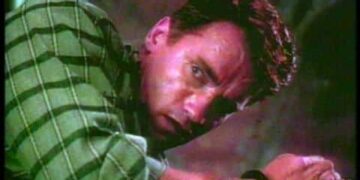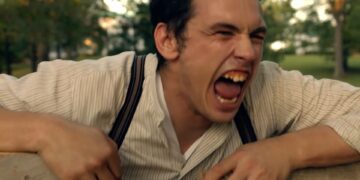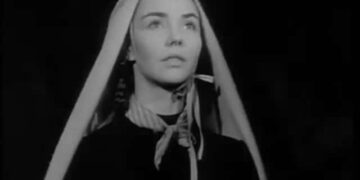As a self-proclaimed fashion aficionado and movie buff, I find myself constantly on the lookout for films that are not only captivating in their storytelling but also in their sartorial splendor. One such classic that marries narrative intrigue with a distinctive visual style is the 1978 thriller ‘The Boys from Brazil.’ Directed by Franklin J. Schaffner and based on the chilling novel by Ira Levin, the film delves into the sinister plot of reviving the Third Reich by cloning none other than Adolf Hitler.
The movie isn’t just a suspenseful ride; it’s a visual feast of 1970s fashion that reflects the era’s complex socio-political landscape. Each character, portrayed by a stellar cast, is meticulously dressed to complement their personality and role in the story, making the film a treasure trove for a character analysis and style breakdown.
In my journey through the wardrobe of ‘The Boys from Brazil,’ I’ll dissect the attire of the key players, sharing insights that will help you not only appreciate the film’s aesthetic but also perhaps inspire your own wardrobe. So, let us wade through the fabric of this cinematic piece, where every thread tells a story.
Character Analysis and Style Breakdown: An Overview
Before we dive into the specifics, it’s important to understand the overall sartorial landscape of ‘The Boys from Brazil.’ The film is set in the 1970s, a time when men’s fashion was undergoing a transformation. The characters in this movie exhibit a range of styles from the quintessentially conservative to the effortlessly suave, each serving as a visual extension of their personas.
- Gregory Peck’s Dr. Josef Mengele: His wardrobe is authoritarian yet has a touch of the flamboyant, reflecting his megalomania and sinister intellect.
- Laurence Olivier’s Ezra Lieberman: His attire is modest, practical, and worn, mirroring his dogged pursuit of truth and justice.
- James Mason’s Eduard Seibert: A man of stature within the narrative, his clothing is polished and proper, underscoring his commanding presence.
Each character’s style is a clue to their role in the narrative, and as we peel back the layers, we find that clothes do much more than just make the man—they define him.
Diving into the Aesthetic of ‘The Boys from Brazil’
‘The Boys from Brazil’ is a film that exudes the aura of its time. The aesthetic is one of contrasts—old world meets new ambition, and the traditional brushes up against the allure of reinvention. It’s a period piece that doesn’t shy away from the boldness of the 70s, yet it maintains a sense of classicism that anchors it in a more sinister past.
From the grandeur of South American villas to the drab confines of a researcher’s office, the settings provide backdrops that amplify the fashion choices. The film’s color palette is both muted and vivid, creating a tapestry that allows the characters’ attire to stand out and speak volumes. It’s as if the 1970s themselves are a character in the film, whispering of a time when the world was reeling from recent history and unsure of the future.
In this blend of shadow and light, the wardrobe designers have managed to capture the essence of each character. The result is a visual dialogue between what is worn and what is conveyed—a dialogue that I’m thrilled to decode.
Gregory Peck as Dr. Josef Mengele
Embodying the nefarious Dr. Josef Mengele, Gregory Peck presented an image that was as chilling as it was sharp. His portrayal demanded a wardrobe that was commanding and meticulous, much like the character’s twisted precision. Let’s dissect the key elements of Mengele’s outfit:
- Tailored Suits: The foundation of Mengele’s wardrobe is his selection of impeccably tailored suits. Dark, solid colors dominate, providing a stark contrast to the lush settings and underlining his ominous presence.
- Crisp Shirts and Ties: Beneath his suits, Peck’s character opts for crisp, white shirts and a collection of ties that range from solid, darker shades to subtly patterned designs. The ties are knotted with precision, never a crease nor a wrinkle out of place.
- Militaristic Touches: While the suits are civilian, there’s a nod to Mengele’s military past with the occasional appearance of a double-breasted jacket, wide lapels, and medals or pins that suggest authority and command.
Dressing like Gregory Peck’s Dr. Mengele means embracing a certain severity and formality. It is an undertaking that requires attention to detail and a penchant for the austere.
Laurence Olivier as Ezra Lieberman
In stark contrast to Mengele’s dark formality, Laurence Olivier’s Ezra Lieberman presents a style that is deeply human and relatable. Lieberman is an aging Nazi hunter, a character that Olivier imbues with a weariness and resilience that is reflected in his attire. Here’s what defines Lieberman’s sartorial choices:
- Functional Outerwear: Lieberman is often seen in a practical overcoat or jacket. It’s attire chosen not for fashion but for function, as befits a man whose life is dedicated to the dogged pursuit of justice.
- Simple Shirts and Slacks: The shirts are plain, sometimes with a subtle pattern, tucked into slacks that are worn but well-kept. This is the uniform of a man for whom style is not a priority, yet who maintains a certain dignity in his dress.
- Accessorizing with Purpose: Whether it’s a hat to shield him from the elements or a watch that’s seen many years, each accessory has a story and a purpose. Lieberman’s style is one of necessity, not flair.
To dress like Olivier’s Ezra Lieberman is to dress unassumingly, with comfort and practicality at the forefront, yet with an underlying sense of self-respect and purpose.
James Mason as Eduard Seibert
James Mason as Eduard Seibert is the epitome of a man who dresses with intention. His role as a staunch supporter of Mengele’s plan is cloaked in a wardrobe that exudes confidence and poise. Seibert’s attire is conservative but speaks volumes of his position within the society he moves in. Here are the key aspects of Seibert’s look:
- Business Attire: Seibert is most often in a suit that is more conservative than Mengele’s, perhaps with a pinstripe or a subdued check. It’s a nod to his professionalism and the facade of respectability he maintains.
- Attention to Grooming: His hair is always neatly combed, his mustache trimmed to perfection. His grooming is as much a part of his style as the clothes he wears.
- Accents of Sophistication: A pocket square, a well-chosen wristwatch, cufflinks—these small touches add a layer of sophistication to Seibert’s appearance, hinting at his taste for the finer things.
To capture the look of James Mason’s character is to understand that style can be a weapon of influence, a means to command respect and assert one’s place in the world.
Lilli Palmer as Esther Lieberman
Lilli Palmer as Esther Lieberman brings a touch of femininity and warmth to the film. Her wardrobe, while not as flashy or prominent as her male counterparts, is rich with character and speaks to her role as the supportive yet strong spouse of Ezra Lieberman. Here’s a glimpse into Esther’s wardrobe:
- Sensible Dresses and Skirts: Esther is often seen in dresses and skirts that are practical and modest. They’re the choices of a woman whose focus is on her family and her husband’s mission.
- Knitwear and Layers: Her attire often includes knitwear, cardigans, or shawls, adding layers that suggest a maternal comfort and a readiness to face the everyday challenges of life.
- Accessories that Add Depth: Whether it’s a brooch, a simple necklace, or a scarf, Esther’s accessories are understated yet add depth to her ensemble, much like her character adds depth to the narrative.
Esther Lieberman’s wardrobe is a reminder that sometimes, the quietest styles can speak the loudest truths. It is about dressing with a sense of purpose and a quiet strength.
Uta Hagen as Frieda Maloney
Uta Hagen’s portrayal of Frieda Maloney is chilling in its normalcy. As a former concentration camp guard now living under an assumed identity, her style is meant to be unassuming, to blend in, yet there is an undercurrent of sternness to it. Here are the elements that make up Frieda’s style:
- Simple, Unadorned Clothing: Frieda’s clothing is straightforward, functional, and devoid of any flourish. Her style is that of someone who wants to draw as little attention to herself as possible.
- Solid Colors and Sturdy Fabrics: The use of solid colors and sturdy fabrics in her wardrobe speaks to her desire to maintain a faí§ade of respectability and normalcy.
- Pragmatic Footwear: Her shoes are sensible, chosen for comfort and practicality over any sense of style or fashion.
Understanding Frieda Maloney’s style is to understand the subtleties of clothing as camouflage, as a way of hiding in plain sight while maintaining a semblance of ordinariness.
Steve Guttenberg as Barry Kohler
Steve Guttenberg, playing the role of the young and impetuous Barry Kohler, provides a contrast in the film through his choice of attire that reflects a more contemporary and unrefined approach. His style is a mix of youthful rebellion and the casualness of the 70s. Here’s what characterizes Kohler’s dressing style:
- Casual Jackets and Jeans: Kohler is often seen in a leather jacket or a casual blazer paired with jeans, reflecting his outsider status and his more modern sensibilities.
- Layered Look: His penchant for layering—whether it’s a shirt under a sweater under a jacket—reveals a practicality and readiness for action.
- Sporty Footwear: Kohler’s footwear tends to be more on the sporty side, sneakers or boots, suitable for someone constantly on the move.
To dress like Guttenberg’s Barry Kohler is to embrace a casual, ready-for-anything approach that is as much a statement of generational identity as it is of personal style.
Denholm Elliott as Sidney Beynon
Denholm Elliott’s Sidney Beynon is a small yet pivotal character in the narrative. His appearance is that of a man somewhat out of his depth, caught in events larger than himself. Beynon’s style is unremarkable, which perfectly suits his role in the story. Here’s what we can deduce from his outfit:
- Business Casual: Beynon’s attire is business casual, the sort worn by a man whose job is important to him, but who does not occupy a position of great power or influence.
- Muted Palette: The colors he wears are muted, perhaps to signify his fading relevance or the overshadowing presence of the more dominant characters.
- Practical Accessories: A briefcase, a pair of glasses—his accessories are chosen for their practicality, not as fashion statements.
To analyze Beynon’s outfit is to see a man trying to maintain a sense of normalcy and professionalism in a world that is rapidly unraveling around him.
Styling Tips for Different Occasions Inspired by ‘The Boys from Brazil’
Taking inspiration from ‘The Boys from Brazil,’ one can craft a wardrobe suitable for a variety of occasions. Here are some styling tips drawn from the film:
- For the Office: Channel your inner Eduard Seibert with a well-tailored suit, a crisp shirt, and a conservative tie. Add a personal touch with a tasteful pocket square or cufflinks.
- Casual Outings: Embrace the Barry Kohler vibe with a leather jacket, a layered look, and comfortable footwear that doesn’t compromise on style.
- Evening Events: Take a page from Dr. Mengele’s book with a dark, formal suit that exudes confidence and authority. Pay attention to grooming and add a subtle accessory that signifies sophistication.
Inspired styling knows no bounds when one draws from a film as rich in character and wardrobe as ‘The Boys from Brazil.’
How to Get the Look: Summary of Outfits and Where to Buy Them
To encapsulate the styles from ‘The Boys from Brazil’ into your wardrobe, here’s a summary of outfits and suggestions on where to acquire them:
- Tailored Suits: For the perfect tailored suit, visit bespoke tailors or reputable stores like Brooks Brothers or SuitSupply.
- Functional Outerwear: Brands like Barbour or Burberry offer durable and stylish overcoats similar to Ezra Lieberman’s.
- Casual Layers: For a casual yet put-together look reminiscent of Barry Kohler, try shops like Levi’s for denim and The North Face for outerwear.
These styles can be adapted and found in many retailers, both online and in physical stores. It’s about capturing the essence, not the exact replica.
Conclusion: The Lasting Impact of ‘The Boys from Brazil’ on Fashion
‘The Boys from Brazil’ is more than a thrilling narrative; it’s a showcase of 1970s fashion through a lens of dramatic storytelling. The character analysis and style breakdown reveal that each costume choice is deliberate, each outfit a narrative device. The film offers a masterclass in how wardrobe can define character, convey subtext, and leave a lasting impact on fashion.
From the tailored severity of Mengele’s suits to the unassuming practicality of Lieberman’s attire, the film’s wardrobe choices continue to inspire and influence. Whether you’re aiming to command a room like Mengele or exude quiet strength like Esther Lieberman, there is something to be learned from the characters of ‘The Boys from Brazil.’
Fashion is, after all, a form of storytelling, and what better way to tell your story than by taking cues from the dapper and the daring of cinema’s past? So go ahead, mix and match, adapt and adopt, but most importantly—make it your own.
Share your unique style tips in the comments and revisit us for the latest updates on fashion advice and exclusive deals!












